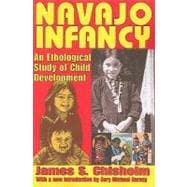
Note: Supplemental materials are not guaranteed with Rental or Used book purchases.
Purchase Benefits
What is included with this book?
| Introduction to the Transaction Edition | p. ix |
| Preface | p. xv |
| Development In an Evolutionary Context | |
| The Process of Adaptation | p. 1 |
| Ontogeny and Phylogeny | p. 12 |
| Adaptability and Development | p. 24 |
| Summary | p. 39 |
| The Environment of Navajo Infancy | |
| Perturbations in the Environment of Navajo Infancy | p. 41 |
| The Navajo | p. 42 |
| Cottonwood Springs | p. 51 |
| The Cradleboard | |
| The Cradleboard and Swaddling in Cross-Cultural Perspective | p. 71 |
| Previous Studies of the Cradleboard | p. 79 |
| The Hypotheses: Does the Cradleboard Affect Navajo Child Development | p. 87 |
| The Research | |
| Anthropology and Ethology in Child Development Research | p. 93 |
| The Samples | p. 97 |
| The Methods | p. 108 |
| The Behavior of Navajo and Anglo Newborn Infants | |
| The Analysis of Brazelton Scale Data: Methods and Rationale | p. 126 |
| Prenatal Influences on Navajo-Anglo Group Differences in Newborn Behavior | p. 130 |
| Discussion and Conclusion | p. 135 |
| Navajo and Anglo Children's Fear of Strangers | |
| Similarities and Differences in Navajo and Anglo Fear of Strangers | p. 142 |
| Environmental Correlates of Navajo Fear of Strangers | p. 152 |
| Discussion and Conclusion | p. 156 |
| Mother-Infant Interaction and The Cradleboard | |
| The Immediate Effects of the Cradleboard | p. 164 |
| Some Situational Determinants of Cradleboard Use | p. 172 |
| The Longer-Term Effects of the Cradleboard | p. 174 |
| Discussion and Conclusion | p. 198 |
| The Determinants of Mother-Infant Interaction | p. 199 |
| Deriving the Determinants | p. 199 |
| Navajo Neonatal Behavior and Mother-Infant Interaction in the First Quarter | p. 203 |
| The Child's Opportunity for Interaction with Others | p. 206 |
| Discussion and Conclusions | p. 212 |
| Summary and Conclusions: Development as Adaptation | |
| Summary | p. 215 |
| Synthesis and Implications | p. 225 |
| Bibliography | p. 251 |
| Index | p. 265 |
| Table of Contents provided by Ingram. All Rights Reserved. |
The New copy of this book will include any supplemental materials advertised. Please check the title of the book to determine if it should include any access cards, study guides, lab manuals, CDs, etc.
The Used, Rental and eBook copies of this book are not guaranteed to include any supplemental materials. Typically, only the book itself is included. This is true even if the title states it includes any access cards, study guides, lab manuals, CDs, etc.